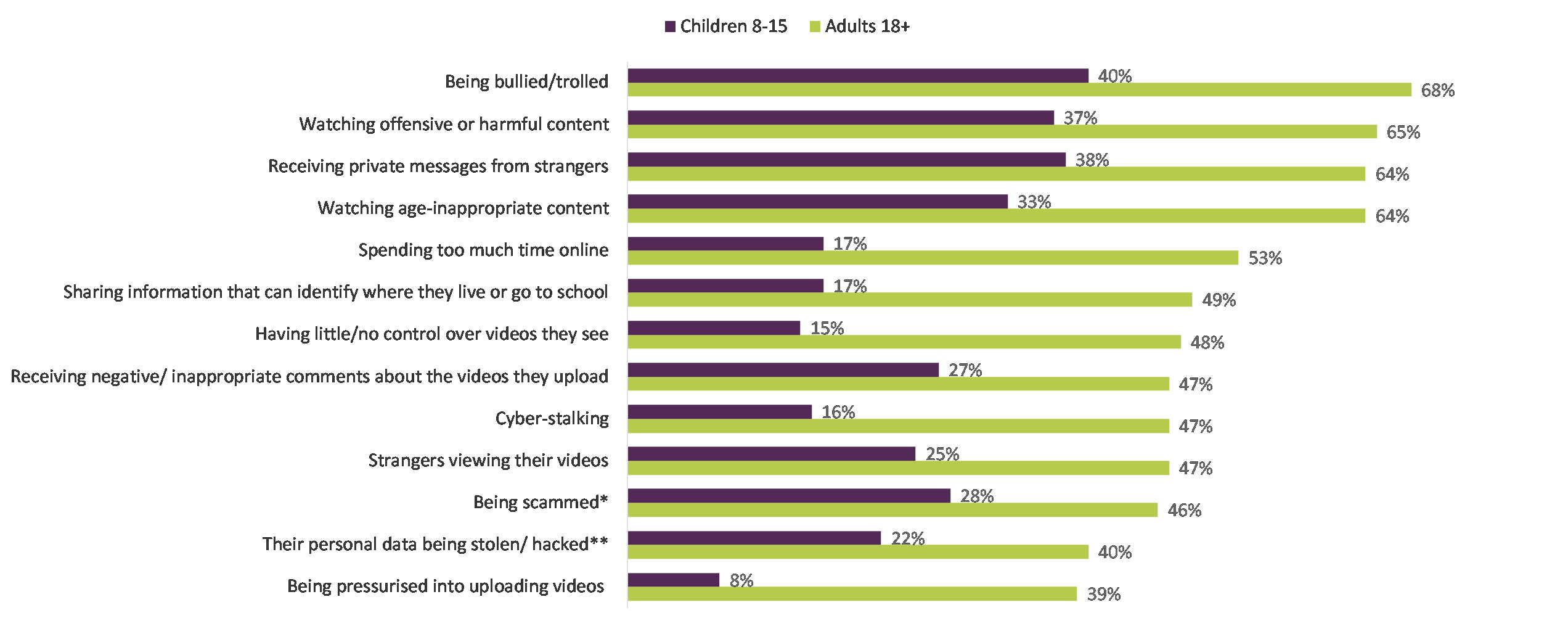- Adults spending record 4 hours a day online on average, as coronavirus changes communications
- Twice as many using video calls to keep in touch during lockdown
- One in three now watch online video more than traditional TV, with two in five making videos themselves
- But nine in 10 online adults have concerns around video-sharing sites and apps
UK adults are now spending more than a quarter of their waking day online – the highest on record – with services such as TikTok and Zoom seeing unprecedented growth, according to Ofcom’s latest study into the nation’s online lives.
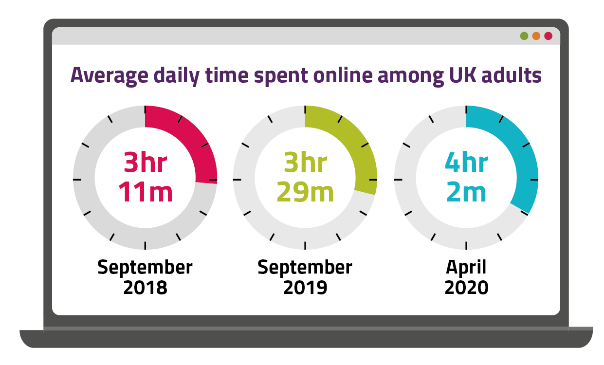
Ofcom’s annual Online Nation[1] report reveals that in April 2020, during the height of lockdown, UK adults spent a daily average of four hours and two minutes online – up from just under three and a half hours in September last year.[2]
With people seeking new ways to keep connected, informed, entertained and fit during the pandemic, emerging video-sharing and video-calling services are surging in popularity.
TikTok, which allows users to create and share short dance, lip-sync, comedy and talent videos, reached 12.9 million UK adult visitors in April, up from just 5.4 million in January. Twitch, the popular live streaming platform for gamers, saw visitors increase from 2.3 million to 4.2 million adults.
The proportion of UK online adults making video calls has also doubled during lockdown, with more than seven in 10 doing so at least weekly. Houseparty, the app which combines group video-calls with games and quizzes, grew from 175,000 adult visitors in January to 4 million in April. But the biggest growth was seen by Zoom, the virtual meeting platform, which grew from 659,000 UK adults to reach 13 million adults over the same period – a rise of almost 2,000%.
A nation of content creators
Sites and apps such as YouTube, Snapchat, Instagram and TikTok, which allow people to create, upload and share videos online, have never been so popular.
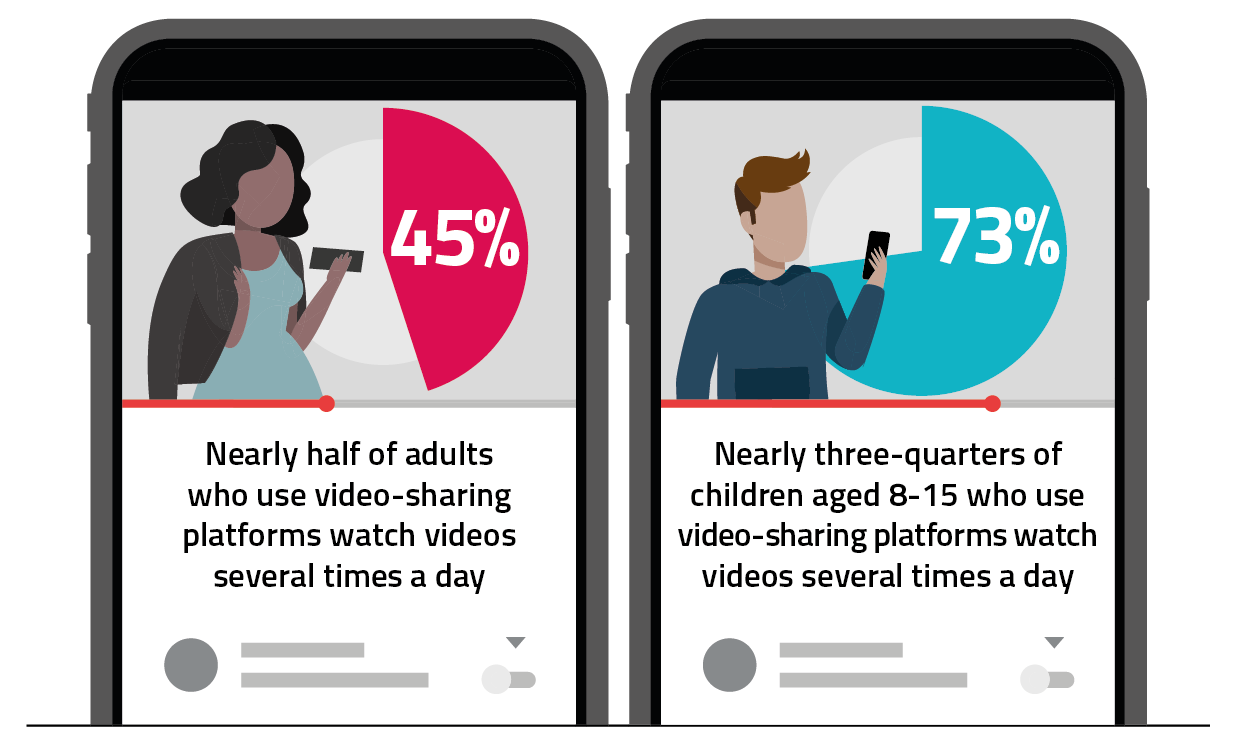
Our report reveals that nine in 10 online adults, and almost all older children aged 8-15, used at least one of these websites and apps in the last year, with many watching videos several times a day. One third (32%) of online adults now spend more time viewing video-sharing services than broadcast television.[3]
And we’re not only watching but creating and broadcasting our own content too. Two in five adults (40%) and 59% of older children who use video-sharing sites and apps now create and upload their own videos, driving an explosion in short-form, user-generated content.
Vlogging is also a money-making enterprise, with 17% of adults who create and upload videos receiving revenue or gifts in return.[4] With some vloggers going on to achieve global celebrity status, the proportion of children under 13 who aspire to become a ‘YouTuber’ had increased by 19% by the end of 2019 compared to 2018.[5] Boys in particular are more likely to consider it as a career.
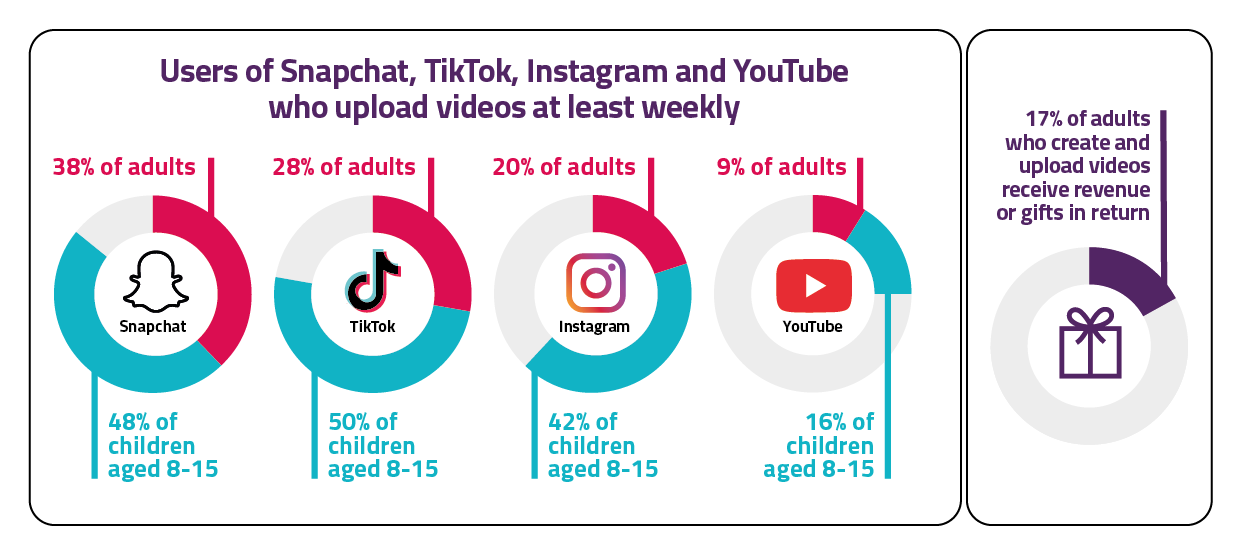
Video-sharing and livestreaming during the Covid-19 pandemic, has also provided a valued means for people to stay in touch, keep informed, and boost their morale. Millions, for example, have watched and participated in Joe Wicks’ P.E. with Joe daily on YouTube; Twitch hosted a Stream Aid charity music event to raise money for the fight against Coronavirus; and TikTok streamed a live Q&A with World Health Organisation experts.[6]
How the pandemic is changing communications
Ofcom’s study shows that, before the Covid-19 pandemic, many people were moving away from more established forms of communication – particularly landline calls and SMS text messages – and adopting newer methods.
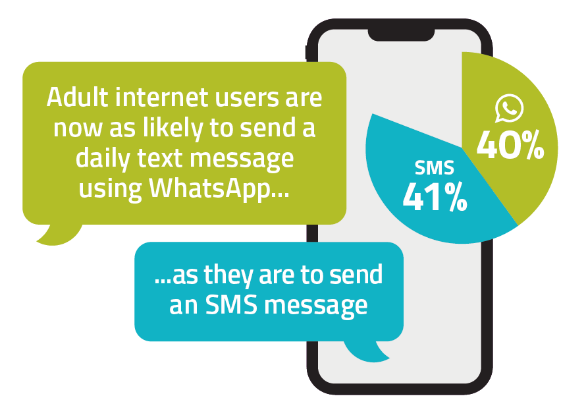
In the 12 months to February 2020, substantially more online adults were sending daily text messages using a variety of online messaging platforms (52%), such as WhatsApp and Facebook Messenger, than using SMS (41%) or email (26%). Daily use of online voice calls (31%) was only slightly lower than mobile calls (38%).
The pandemic appears to have accelerated the adoption of online services to keep in touch with friends and family. More than seven in 10 online adults in the UK are now making video calls at least weekly, up from 35% pre-lockdown. This trend is particularly noticeable among older internet users; the proportion of online adults aged 65+ who make a least one video-call each week increased from 22% in February 2020 to 61% by May 2020.
The proportion of UK adults who used established online services to make video calls at least weekly during lockdown – with WhatsApp reaching 49% in May (up from 20% in February); Facebook Messenger 41% (from 18%); and FaceTime 30% (from 13%).).
But the most dramatic increases have been in the use of Zoom (which reached 659,000 adult internet users in January and 13 million in April), Microsoft Teams (3 million versus 6.5 million) and Houseparty (175,000 versus 4 million).
Confident but cautious
For many adults and children, watching or creating content on video-sharing sites or apps is a positive experience.[7] But 87% of adults – and 79% of 8-15 year olds – have concerns around children using these platforms. Bullying or trolling, harmful or age-inappropriate content and receiving private messages from strangers are among the top concerns.[8]
Adults’ trust in sites to remove illegal, offensive and harmful material has grown by seven percentage points since last year, to 54%. Nevertheless, most adults (57%) continue to support greater regulation of video-sharing platforms (64% in 2019).
Ofcom is preparing to take on new duties for the regulation of UK-based video-sharing platforms. This summer, we will be publishing a call for evidence to inform our guidance on the measures platforms should adopt to protect users from harmful content.
Yih-Choung Teh, Ofcom’s Director of Strategy and Research, said: “Lockdown may leave a lasting digital legacy. The coronavirus has radically changed the way we live, work and communicate online, with millions of people using online video services for the first time.
“As the way we communicate evolves and people broaden their online horizons, our role is to help ensure that people have a positive experience, and that they’re safe and protected.”
NOTES TO EDITORS
- Online Nation brings together research produced by Ofcom and third-party providers; an overview of our methodology is published as an annex to this report. The report includes new research conducted by Populus in 2020 on video-sharing platforms and online communication services. Third-party sources used include Comscore, the UKOM approved partner for online media audience measurement since 2012, and Kids Insights UK, a market research and insights resource on children aged 3-18 years old.
Separately, we have also published our annual research on Internet users’ concerns about and experience of potential online harms, commissioned jointly with the ICO, and our Adults’ Media Use and Attitudes Report 2020. - This rises to over half (57%) of 18-24 year olds.UK adult visitors to YouTube spent an average of 28 minutes 52 seconds on the site per day in September 2019; while 18-24s spent more than twice as long (one hour and five minutes). During lockdown (April 2020), average daily time spent on YouTube increased to 43 minutes and 7 seconds among adult visitors, and to one hour 32 minutes among 18-24s (excludes YouTube TV set use).
- 18-24s continued to be the group spending the most time online (averaging 5 hours 4 minutes online per day in April 2020)
- Of those who reported earning any form of revenue from uploading their videos, 57% were aged 18-34, 38% were 35-54 and 5% were over 55. Revenue sources include having a formal partnership with a brand, gifts from companies and brands in return for promotion, advertising revenue and financial donation or subscription payments from viewers/fans. A higher proportion of male adults who uploaded videos reported earning revenue (21%) compared to female adults (13%)
- Source: Kids Insights UK, Q4 2018 and 2019
- Similarly, many video-sharing platforms have introduced new product features quickly in response to the coronavirus pandemic. Instagram introduced a shared story to help those practicing social distancing connect with others, using a ‘Stay Home’ sticker. TikTok’s #IsolationGames challenge connects users with Team GB athletes, and Snapchat has partnered with the WHO to launch a filter promoting WHO safety tips and guidelines.
- Reasons for creating videos for video-sharing sites or apps
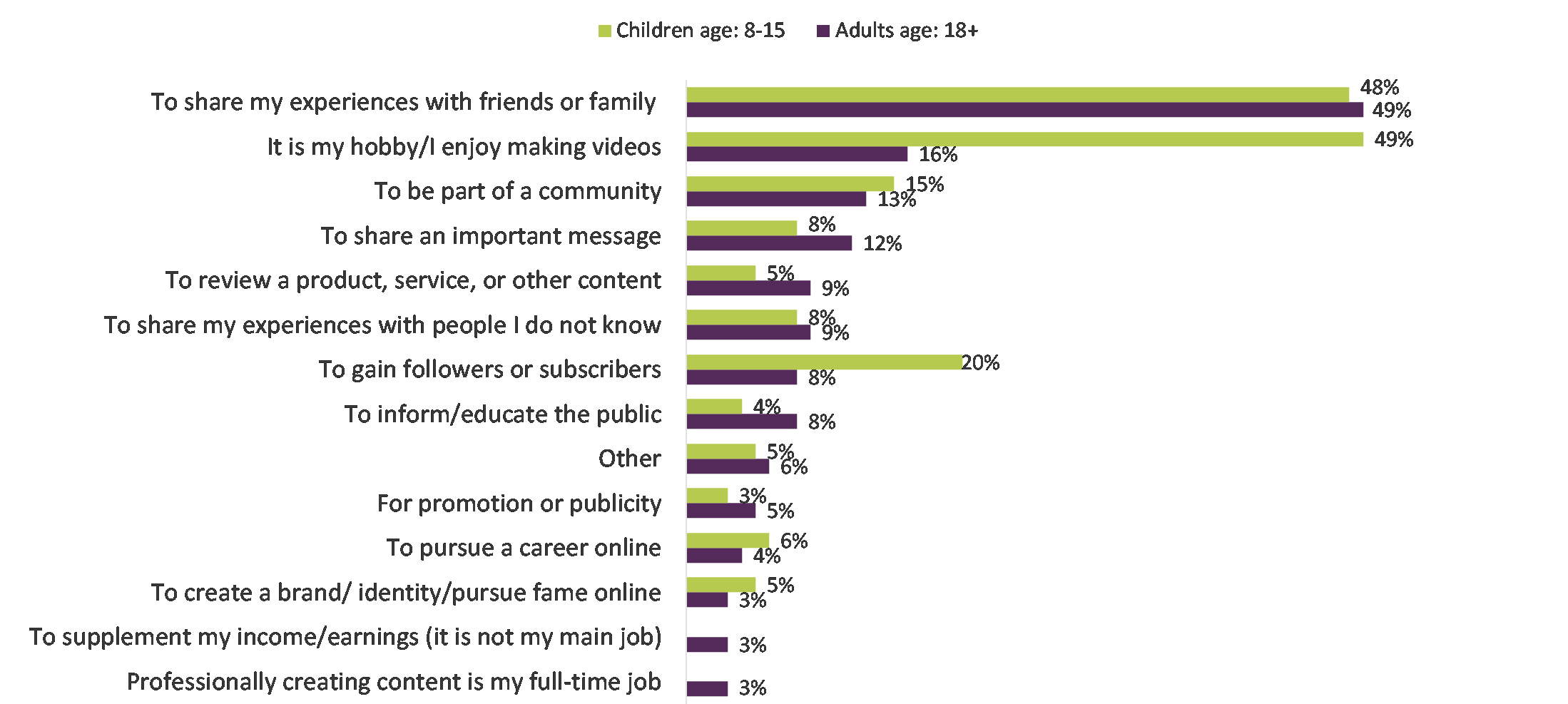
- Adults’ and children’s concerns in relation to children using VSPs
